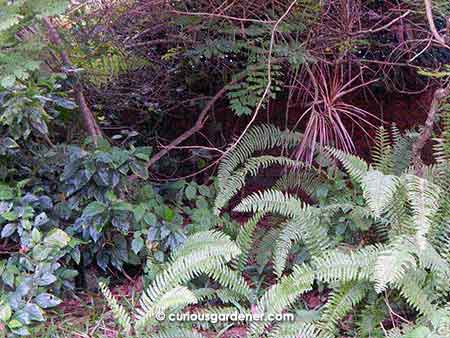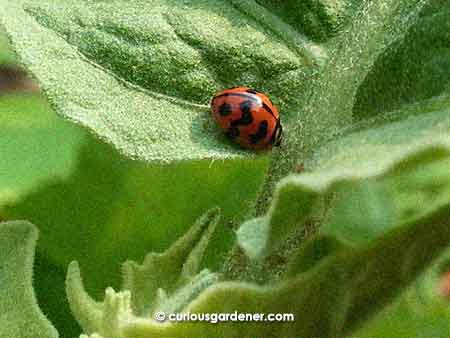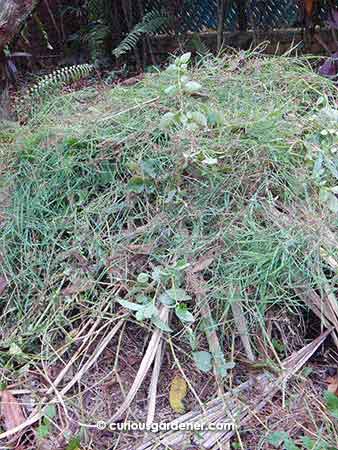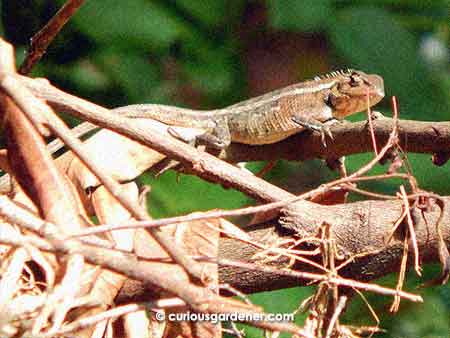I used to abide by the neat, manicured garden rule when I first got interested in gardening about 15 years ago. However, over time, I’ve gravitated towards a more “natural” garden.
Now, when I use the word “natural”, I don’t mean it as an euphemism for being overgrown with weeds – although that may seem to be the case lately. Really.
Really!

In permaculture, the garden is divided into different zones. The first three are closely monitored for plants, and the last two are left more to nature, because we do need to share the place with beneficial creatures. This is our Zone 4 (semi-managed).
What I want is for our garden to be a place that has lots of life in it – flora as well as fauna. Flora is fairly controllable – we plant and move and nurture our plants – but fauna is more challenging. We can’t control the creatures that come in as easily as we do the plants (excepting domesticated pets – and then, we’re still not really in control!).

These days, I welcome the presence of aphids, because that means we’ll see the ladybugs that come to feed on them – and usually breed on the same plant at the same time that they eradicate the aphid population. This proves the point that if you provide the environment, the desired fauna will move in.
As a child growing up in the developmental stage of this country, I remember having all kinds of creatures around – from the now extinct green tree lizards to huge palm-sized spiders, and lots of grasshoppers and red ladybugs, just to name some. We used to listen to owls and nightjars, and the chorus of croaking frogs and toads mating; and one of my favourite things was to go to an empty, muddy piece of unused land nearby and observe the different frog and toad eggs floating in those muddy puddles and to bring tadpoles home to watch how they developed into their adult forms.

One of the messy-looking compost piles. I try to add brown and green matter to them at least once a fortnight.
Fast-forward to the 1980s and 90s, and all of those things pretty much disappeared. I certainly don’t miss the rats and snakes (when the neighbourhood was still in the “kampong” stage), but it felt like the garden had become quite sterile for a long stretch of time. Just to make my point, when we were young, the dogs were always catching and killing things in the garden. Then it seemed like they didn’t do much. Then in the last 10 years we began to notice more fresh kills lying around – usually garden moles (shrews) and Oriental garden lizards (that replaced green tree lizards). These creatures showed that nature was making a comeback, and as you know, I’ve been observing the fauna activity since then. Hence my previous posts on the Asian toad, banded bullfrog, different birds and so on, when they showed up.
(Above) A magpie-robin searches through leaf litter at the edge of one of the compost piles. Sorry for the jerky filming, but this was taken from a distance away and was not easy to catch. In fact, I’ve never been able to get such footage again (but I live in hope!).What I realised was that if we wanted our garden to be a place for fauna to thrive, we needed to make it an environment friendly to them. So, following the principles of permaculture, there are some Zone 4 (semi-managed) areas that I hardly venture into, except for pruning the plants there. This paid off when the magpie began to visit more often, and nested for a while. I’ve also built up a few compost heaps that are attracting all kinds of things, from insects to birds and lizards that feed on the insects. It looks messy but there’s just so much to observe.
Besides the compost heaps, I also leave broken flower pots or small piles of stones or sticks that act as homes for things that need to hide. Once upon a time, this used to mean only snails. Today, we can expand that to include frogs and toads – just a couple of them, but better than none! We are still working on the balance of things here, but we are very pleased with the return of more fauna activity.
© 2014 curiousgardener.com All rights reserved.

